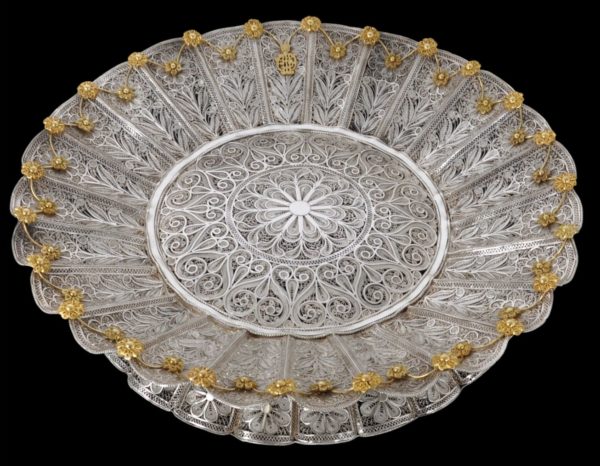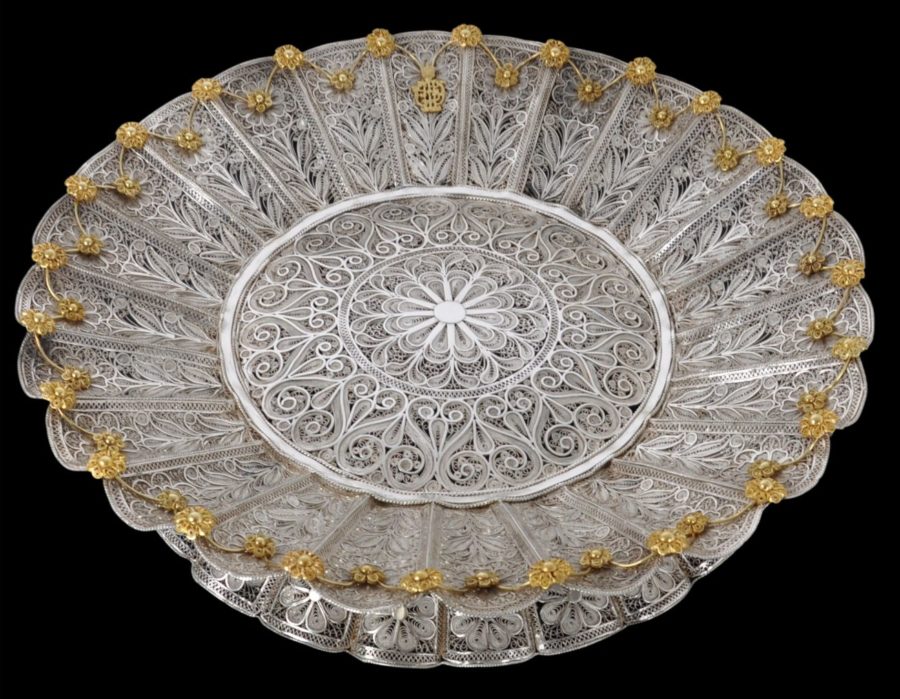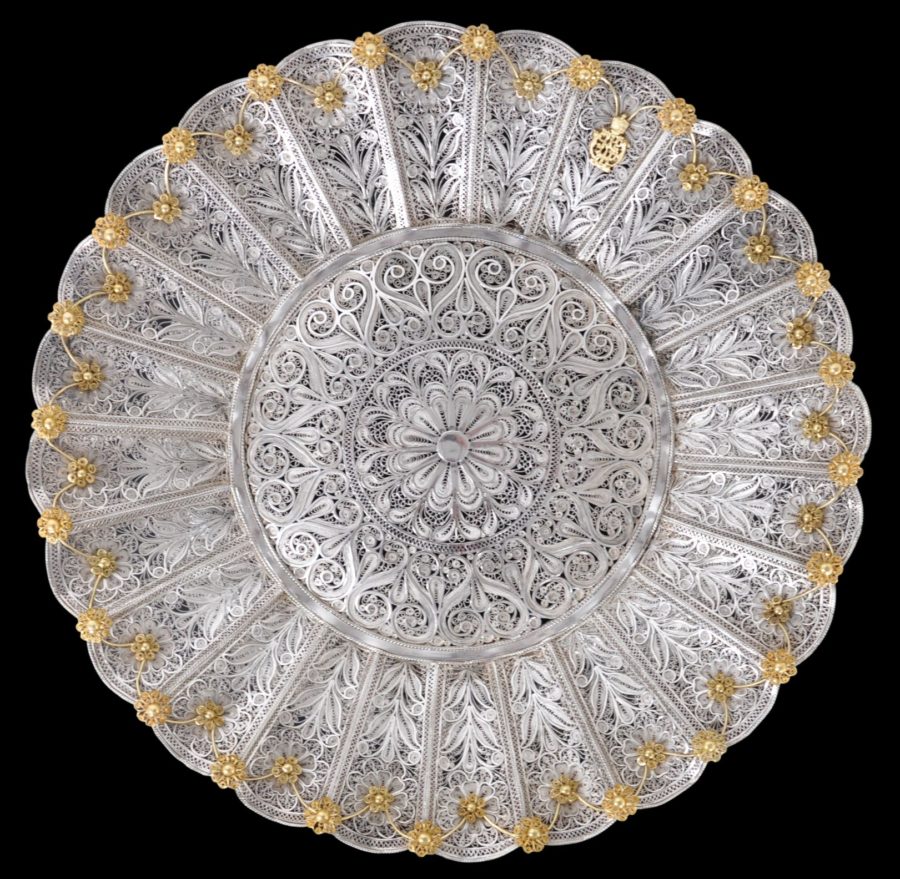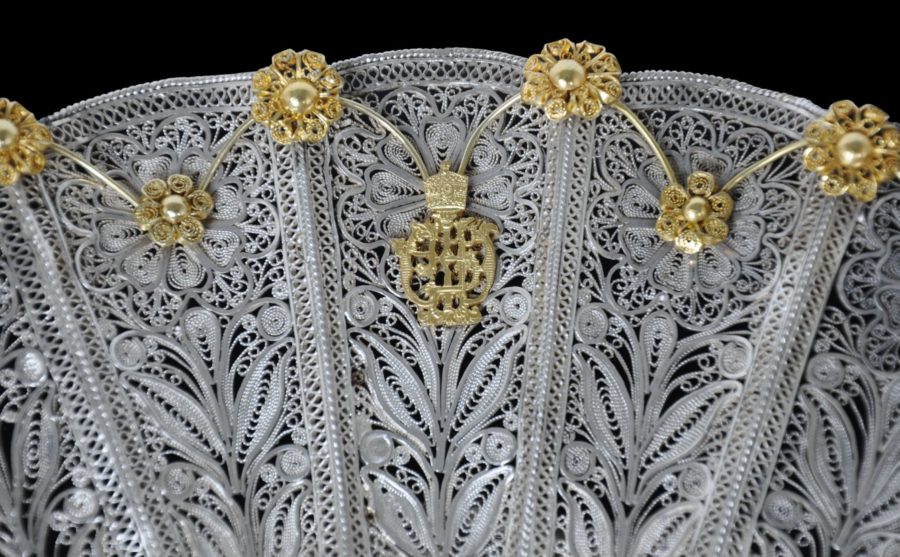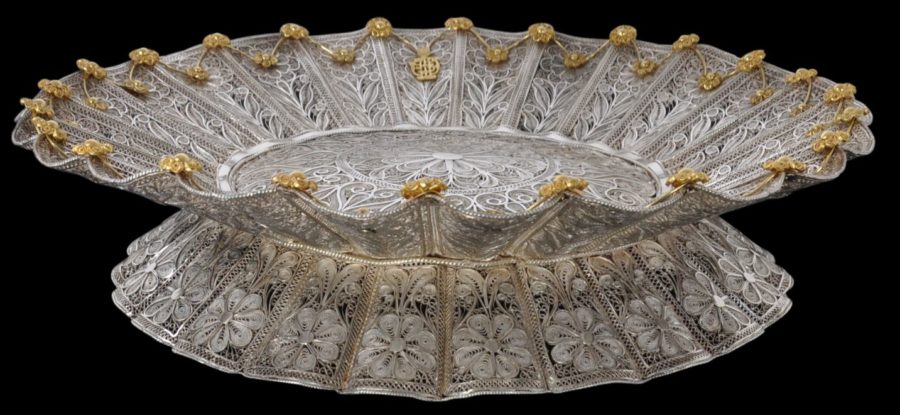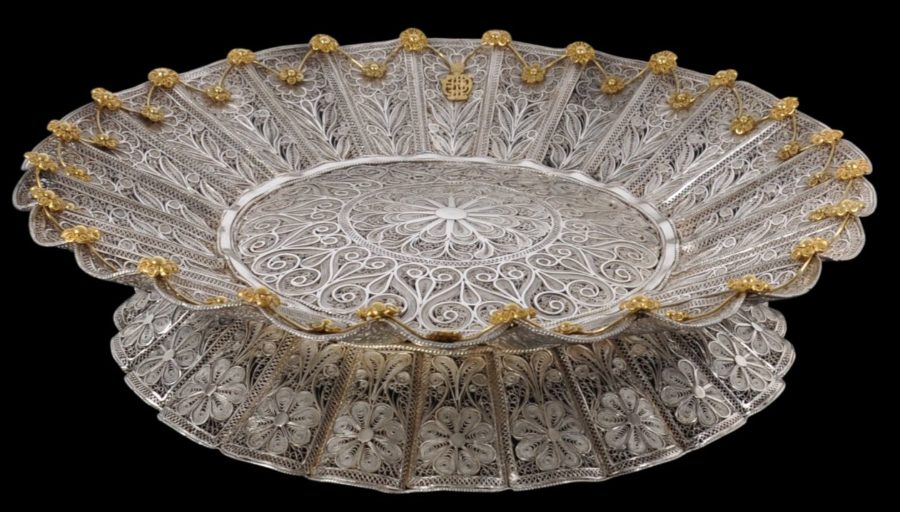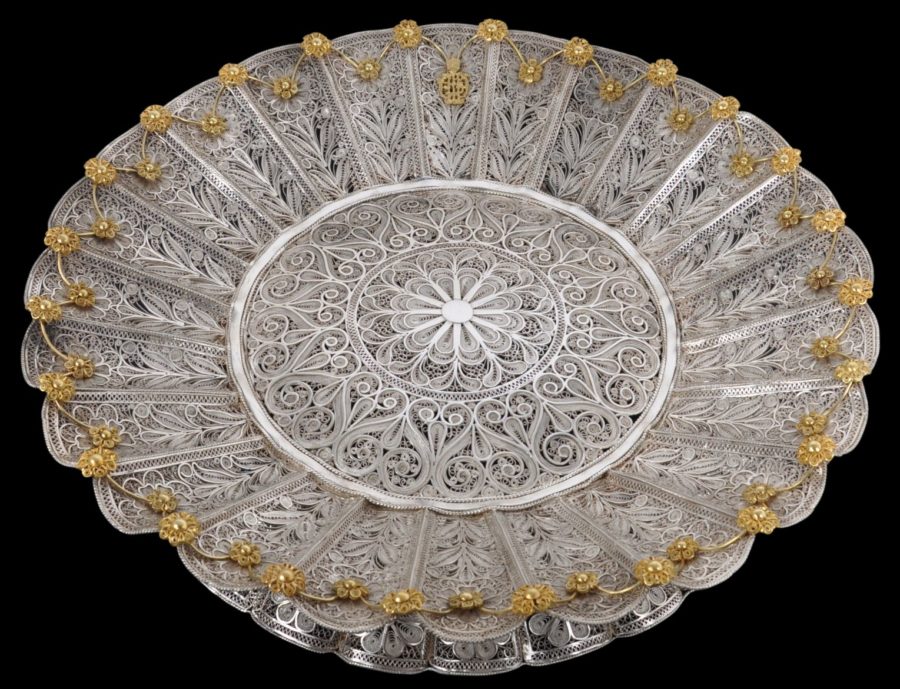Enquiry about object: 6049
Large Silver & Gilt Filigree Bowl Presented to Prime Minister Harold Wilson by Emperor Haile Selassie
Addis Ababa, Ethiopia circa 1968
diameter: 38.3cm, height: 9.2cm, weight: 2,229g
Provenance
Presented to Prime Minister Harold Wilson of the United Kingdom by Haile Selassie, Emperor of Ethiopia; from the estate of Lady Wilson, the former Prime Minister's wife.
This large silver and silver-gilt bowl was presented by Haile Selassie, Emperor of Ethiopia, to British Prime Minister Harold Wilson, most probably on the latter’s official visit to Ethiopia in 1969.
It weighs more than two kilograms and yet is made of fine filigree.
The bowl has come from the estate of Lady Wilson, the former prime minister’s widow. Sir Harold Wilson, later Baron Wilson of Rievaulx (1916-1995) served as British Prime minister twice from 1964 t0 1970, and again from 1974 to 1976. (This type of silver filigree work traditionally was done in Ethiopia and Selassie’s palace commissioned such extravagant examples of filigree silver from at least one local Addis Ababa master craftsman in particular in the 1960s.)
The bowl is massive by filigree standards. It is wide and stands on a splayed filigree foot, almost as wide as the top section of the bowl. The edges and base are of fluted or scalloped form. The filigree is arrayed as leaves and flowers. The bowl comprises no less than 24 flutes around the sides.
The interior edge of the bowl is ringed by a gold-plated wire-work that links a gold-plated silver flower at the crest of each scallop. One of the scallops or flutes includes the cypher for Haile Selassie over which is the tiered crown of the emperors of Ethiopia.
A related bowl of silver filigree and with applied gilded filigree plaques was presented to President John F. Kennedy by Emperor Haile Selassie during his state visit to the White House in October 1963. That bowl now is in the collection of the John F. Kennedy Presidential Library and Museum in Boston, Massachusetts (accession number MO63.1306). The Emperor presented to Jacqueline Kennedy a gold filigree purse with similar filigree work. Several photographs of Mrs Kennedy taken subsequently showed her using the purse on official occasions. And in the past we have also had a similar but smaller example which was presented around 1969 to Sheikh Zayed bin Sultan Al Nahyan, the then ruler of Abu Dhabi.
The bowl is in the north African tradition of silver and gold filigree work. Silver filigree of this type is similar to that made by Muslim craftsmen in India and may reflect their influence. Equally, local Jewish silversmiths often produced silver filigree items for Muslim clients in the Maghreb and the Middle East. Earlier interest in filigree in Africa might also have been encouraged by Portuguese traders and colonialists. The Iberian peninsula often is thought of as an originating source of know-how and demand for silver and gold filigree work. The work on the bowl here is also very similar to East African filigree silver work normally ascribed to Sudan (see for example Al-Jadir, 1981).
Brus (2011, p. 303) illustrates the crown of the Ethiopian Orthodox Dean of the Emperor Menelik II Mausoleum made of gold filigree but which exhibits essentially identical filigree techniques as the dish here. Brus attributes it to ‘after the Second World War’. It, like the bowl, almost certainly is the product of Addis Ababa craftsmen.
The bowl is in excellent condition.
Haile Selassie I was Emperor of Ethiopia from 1930 to 1974. Born in 1892 with the princely name of Lij Tafari Makonnen, he assumed the name of Haile Selassie after his coronation. His full title was ‘His Imperial Majesty Haile Selassie I, Conquering Lion of the Tribe of Judah, King of Kings, Emperor of Ethiopia, Elect of God.’
He was the heir to a dynasty that traced its origins to the 13th century, and from there by tradition back to King Solomon and Queen Makeda, Empress of Axum, also known as the Queen of Sheba.
Later, Haile Selassie would be revered by Rastafarians as the returned messiah of the Bible. Their movement originated in Jamaica in the 1930s and regarded Selassie as a messianic figure who will lead a future golden age of eternal peace, righteousness, and prosperity. Haile Selassie himself was an Ethiopian Orthodox Christian throughout his life.
As emperor, Haile Selassie was a close ally of the West. He introduced Ethiopia’s first written constitution in 1931, providing for a bicameral legislature. The constitution kept power in the hands of the nobility, but it did establish democratic standards among the nobility, envisaging a transition to democratic rule. But not long after, he had to flee his country and go into exile.
Ethiopia became the target of renewed Italian imperialist designs in the 1930s when Benito Mussolini’s forces invaded in 1935. Haile Selassie joined his northern armies and set up headquarters in Wollo province. For two years, the fronts shifted alternatively favouring the invading Italians and then the Ethiopians.
When the struggle to resist Italy appeared doomed, Haile Selassie travelled to the rock-hewn churches of Lalibela to fast and pray. To protect the royal family and the succession it was decided that the emperor’s wife Menen Asfaw and the rest of the family should depart for Djibouti and from there continue on to Jerusalem where the imperial family maintained a residence. It was soon agreed that Selassie should follow.
The choice of Jerusalem was highly symbolic, since the Imperial family claimed descent from the House of David. From there Selassie made his way to London and then to Switzerland to address the League of Nations in 1936. His speech to the League is regarded as one of the great speeches of the twentieth century.
Noting that his own small country could never withstand an attack by a large power such as Italy, with its ‘unlimited quantities of … death-dealing weapons’, he contended that all small states were threatened by the aggression, and that all small states were in effect reduced to vassal states in the absence of collective action. The speech made the emperor an icon for anti-fascists around the world, and Time magazine named him ‘Man of the Year’.
Haile Selassie spent his years in exile (1936–1941) in Bath, UK, in Fairfield House, a 14-room Georgian house, which he bought, and which he donated to the city of Bath on his return to Ethiopia after the occupying Italian forces were forced out.
A first significant act on his return was to abolish the legal basis of slavery and the imposition of severe penalties, including death, for slave trading. Other legal reforms were passed but Ethiopia remained semi-feudal in the face of opposition from the nobility.
Famine and the oil shocks of the 1970s hit the Ethiopian economy hard. Marxism took root among the intelligentsia and for the first time, the authority of the Emperor was questioned widely. A military coup saw Haile Selassie’s downfall and the rise of Colonel Mengistu Haile Mariam. The last months of the emperor’s life were spent under house arrest in the Grand Palace.
In November 1974, sixty former senior officials of the imperial government were executed without trial. The executed included Haile Selassie’s grandson and two former Prime Ministers.
On 27 August 1975, Haile Selassie died reportedly from respiratory failure following complications from a prostate operation, a claim later denied by his doctor. Many believe that Selassie was murdered.
With this background, the bowl is a relatively rare and yet highly decorative relic of one the twentieth century’s most intriguing rulers. It is also notable for the other aspect of its provenance – an official gift to a then British Prime Minister.
References
Al-Jadir, S., Arab & Islamic Silver, Stacey International, 1981.
Brus, R., Crown Jewellery: And Regalia of the World, Pepin Press, 2011.


